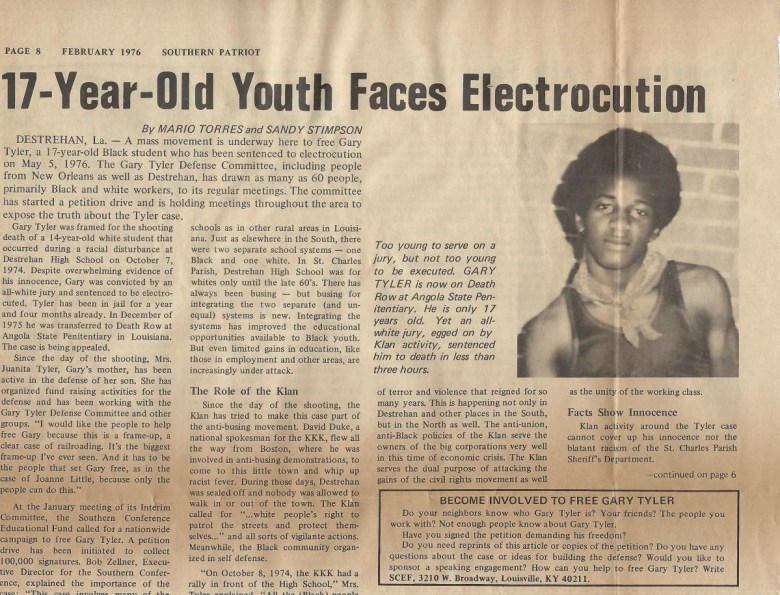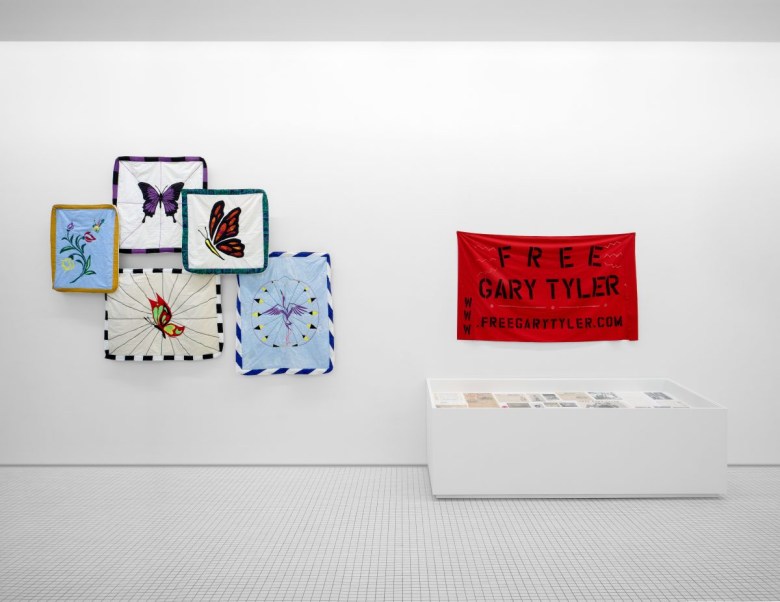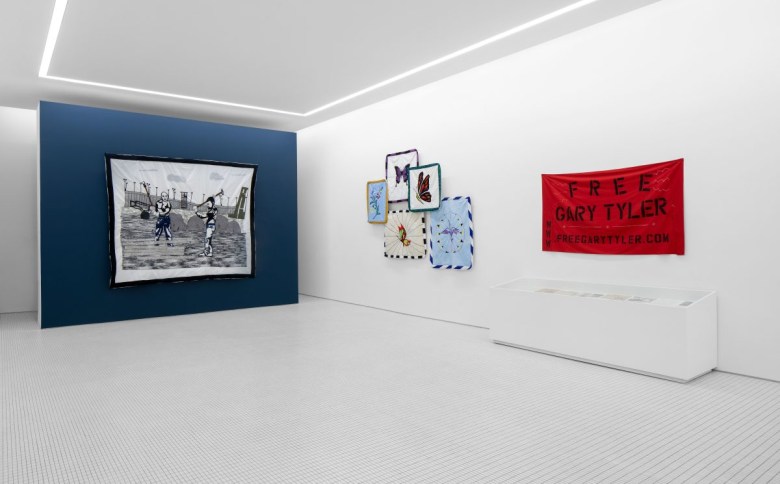LOS ANGELES — At 16 years old, Gary Tyler was arrested by the police in St. Charles, Louisiana, following an incident in which he and a group of other Black American students were attacked by a crowd of White people while riding a bus home from school. Desegregation had been mandated in the 1954 historic ruling Brown v. Board of Education, but 20 years later, in 1974, the White community was still resistant to integration. During this confrontation, a 13-year-old White boy named Timothy Weber was killed by a gunshot. Many witnesses, including the bus driver, said this shot came from outside the bus Tyler was riding.
Inspired by a trip he had recently taken to California, where he was reportedly first exposed to the Black Panther Party and the concept of racial equality, Tyler spoke back to an officer during the ensuing investigation at the scene, considered an unwritten crime on par with tyranny or blasphemy in the rural South. Tyler was arrested, beaten, and charged with the crime as a symbolic representation of what happens to a Black person who “steps out of line.”
In November 1975, he was convicted of first-degree murder by an all-White jury, sentenced to death row, and sent to Louisiana’s maximum-security Angola prison. His trial attracted the attention of prominent racial justice advocates such as Rosa Parks, who said at a 1976 rally in his support: “If there is any strength that I have left I will do whatever I can to help free this young brother.” In 1980, the United States Court of Appeals for the Fifth Circuit reversed its earlier ruling, claiming that Tyler’s trial was “fundamentally unfair.” However, that ruling was overturned a year later, sentencing Tyler to 41 years in prison.

On April 29, 2016, Tyler was finally released at age 57. He entered a technical guilty plea to secure his release. Because of this, he receives no reimbursement for his time in prison, nor does the state acknowledge any responsibility for this injustice, but he is free. I sat down with Tyler in his Los Angeles studio, where he had been busy working at nights after his day job as lead outreach and engagement support worker for Safe Place for Youth, an organization that serves unhoused young people. A position he is particularly suited for, this job affords him the stability necessary to maintain his life and studio practice and gives him an opportunity to support youth facing a variety of issues, from social and racial inequality to dysfunctional family systems and trauma. When we met, Tyler had just shipped a slew of quilted artworks in anticipation of his first solo exhibition, We are the Willing, curated by Allison Glenn at Library Street Collective in Detroit through September 6.

Tyler learned how to quilt during his incarceration, when he got involved in a charity that raised funds to help family members visit their loved ones in prison, especially those in hospice care. One of the ways the charity raised money was by auctioning off quilts made by incarcerated people at local rodeos. “My mother and grandmother both used to sew, and it made me feel good to be connected to them like that,” he said.
Tyler’s eyes lit up when he spoke of his mother, Juanita Tyler, who spent the rest of her life working for his release. “Your first love in life is your mother. No one loves you like your mother does,” he said. His only regret about his time in prison, he added, is that she passed away before he found freedom.
Much of the work in We are the Willing references the way Tyler is now adapting to life after incarceration. In a series of small quilts hung together on the wall of Library Street Collective, he uses butterflies as symbols for this transition: “I saw my time in prison as being almost like a cocoon; now that I am free it’s like I’m a butterfly.”
“Ray of Freedom” (2023) depicts a Louisiana crane species that Tyler would often see around the Angola prison grounds. Perhaps one of the most poignant aspects of this exhibition is its most obvious: a man whom the state of Louisiana once deemed so dangerous that he deserved the death penalty at age 17 now uses his freedom to make quilted artworks, a symbol of warmth, tenderness, and home.

It is not lost on Tyler that up until his release he has spent the entirety of his life supervised by others — his parents until the age of 16 and the state of Louisiana afterwards. These past six years of freedom are the first time he has had real agency over his choices and experiences, a state he describes as “catching up.” While he certainly kept himself busy during his time in prison, also earning a degree in graphic design, he had to learn some basic, day-to-day realities we often take for granted, including paying rent or using a computer. He described his first time going to a grocery store as “surreal.”
As a whole, the exhibition can be thought of as a self-portrait, from the symbolic butterfly quilts to the pieces in which Tyler depicts himself in the work, as in “Captivity, 1974” (2023), a quilted version of a photo taken shortly after his initial arrest at the age of 16. While this is his first solo art exhibition, Tyler is quite a familiar name among others who have been wrongly accused, and his reputation and image precede him. The work is his way to reclaim authorship of his story — to declare that he is an artist, not just a man who was wrongly convicted.

In this new, free life, Tyler finds himself among the many artists who use their lived experiences to shine a light on the realities of our world. In the work “December 14th, 1975” (2023), he quilted a picture of himself and other men on death row at Angola. As the youngest of the group, he was taken under the wings of older incarcerated people such as Albert Woodfox, a member of the Angola Three who served decades in solitary confinement before his conviction was overturned and he was released. Tyler remembers these mentors fondly: “They helped me understand how to speak on my own behalf; when I got into prison I had no idea what a political organization was.” In this quilt, Tyler is obscured by prison bars, and the dehumanizing nature of incarceration becomes palpably clear, with a large number marking the cell block more easily identifiable than the person in it.
In the exhibition’s largest work, “Remembrance” (2023), Tyler pays homage to a fellow incarcerated man and friend, Leslie Smith. Depicting the two men working together outdoors, it almost feels like a historical painting. At an artist talk prior to the exhibition’s opening, Tyler relayed that shortly after this picture was taken, Smith became sick, was diagnosed with AIDS, and died about a month later. This piece, like the others, is largely black and white, with a burst of blue defining the work jeans worn by the figures.

Near the butterfly quilts hangs a banner that reads “FREE GARY TYLER.” Underneath this banner, a vitrine full of ephemera from his wrongful conviction and ultimate freedom informs the viewer of his story. Yet, ultimately, the greatest power in We are the Willing, and by extension in Tyler’s actual life, lies not in the past but in the future. “I don’t want people to pity me,” he said. “I’m interested in what I am becoming.”
This article was made possible through the support of the Sam Francis Foundation in honor of the 100th birthday of Sam Francis.
This post was originally published on this site be sure to check out more of their content.






